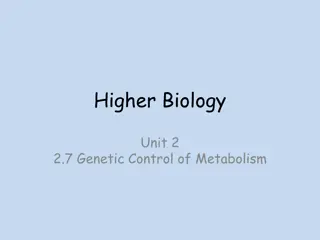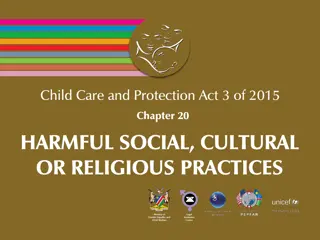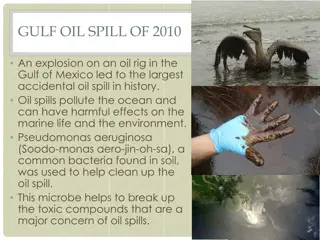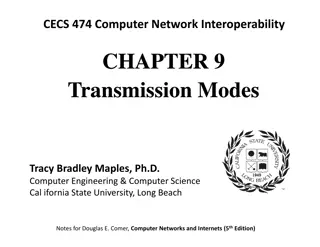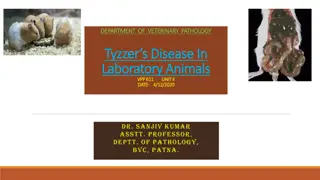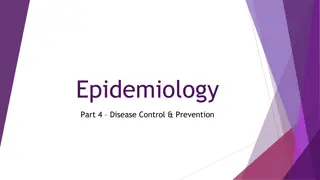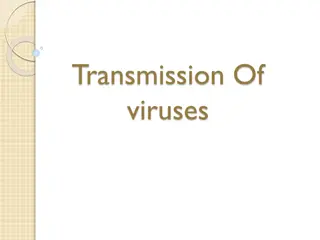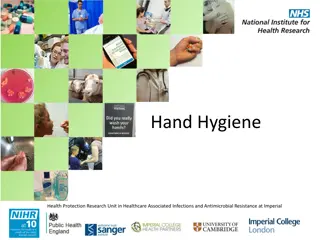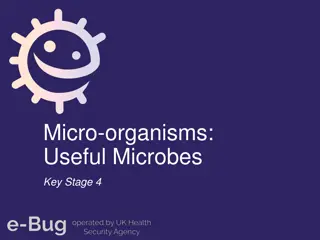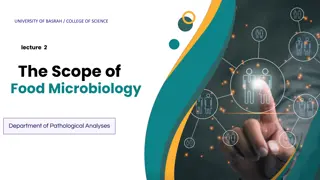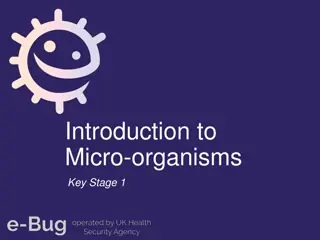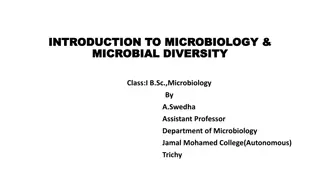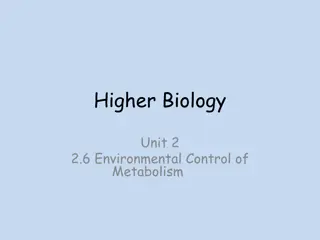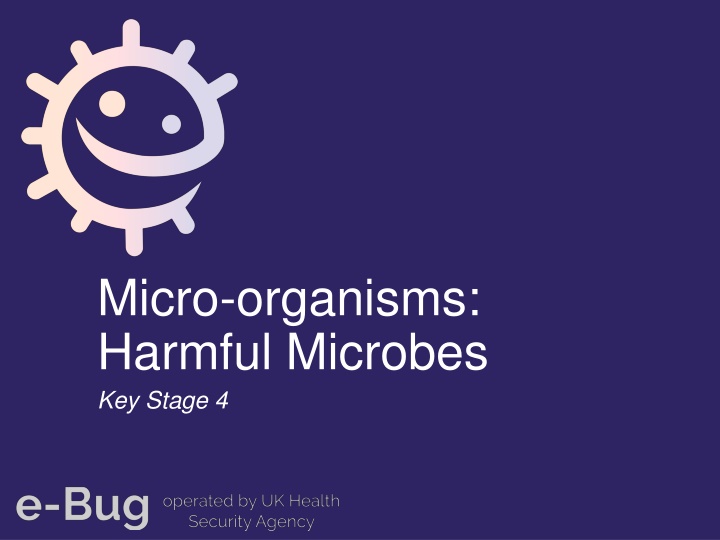
Harmful Microbes and Disease Transmission
Micro-organisms, such as bacteria, viruses, and fungi, can be harmful to humans, causing diseases through various modes of transmission. Learn about pathogenic microbes, their impact on health, and how they spread from person to person. Explore the role of lifestyle factors and global travel in the transmission of infectious diseases.
Download Presentation

Please find below an Image/Link to download the presentation.
The content on the website is provided AS IS for your information and personal use only. It may not be sold, licensed, or shared on other websites without obtaining consent from the author. If you encounter any issues during the download, it is possible that the publisher has removed the file from their server.
You are allowed to download the files provided on this website for personal or commercial use, subject to the condition that they are used lawfully. All files are the property of their respective owners.
The content on the website is provided AS IS for your information and personal use only. It may not be sold, licensed, or shared on other websites without obtaining consent from the author.
E N D
Presentation Transcript
Micro-organisms: Harmful Microbes Key Stage 4
Learning Outcomes All students will: Understand that sometimes microbes can make us ill and cause infection. Understand how harmful microbes (pathogens) can pass from person to person. Understand that different infections can have different associated symptoms. Understand how global travel has influenced the spread of disease. Most students will: Understand how infectious diseases impact the local community. e-Bug.eu
Curriculum Links PHSE/RHSE Health and prevention Science Working scientifically Scientific attitudes Experimental skills and investigations Biology Communicable diseases Structure and function of living organisms Cells and organisation Nutrition and digestion English Reading Writing Art & Design Graphic communication e-Bug.eu
What are Harmful Microbes? Sometimes microbes can be harmful to humans and cause disease. These are known as pathogenic microbes. Once bacteria and viruses enter your body, they can reproduce rapidly. Bacteria can also divide by binary fission and produce toxins when they reproduce which are harmful to the body. Viruses act like parasites multiplying inside our cells and destroying them. Some fungi like to grow on our skin making it itchy and sore. In the early 1900s the disease of greatest threat was measles; many children who caught measles died. e-Bug.eu
What are Harmful Microbes? There are 4 main mode of transmission for pathogenic microbes. First - by air including droplet transmission many pathogens are carried and spread from one organism to another by air. When you are ill, you expel tiny droplets full of pathogens from your respiratory system when you cough, sneeze, or talk. Other people breathe in the droplets, along with the pathogens they contain, so they pick up the infection. Examples include flu (influenza), tuberculosis, and the common cold. Second - direct contact - spread by direct contact of an infected organism with a healthy one. Pathogens such as the viruses which cause HIV/AIDS or hepatitis enter the body through direct sexual contact, cuts, scratches, and needle punctures that give access to the blood. e-Bug.eu
What are Harmful Microbes? Third - by consumption - eating raw, undercooked, or contaminated food, or drinking water containing sewage can spread diseases such as diarrhoeal diseases, cholera, or salmonellosis. The pathogen enters your body through your digestive system. Fourth - vector some diseases e.g. malaria, are vector-borne, this means that some living organism can transmit infectious pathogens between humans, or from animals to humans. Lifestyle factors often affect the spread of disease. For example, when people live in crowded conditions with no sewage system, infectious diseases can spread very rapidly. Someone who has contracted harmful disease-causing microbes is said to be infected. e-Bug.eu
Main Activity: Harmful Microbes and Their Diseases e-Bug.eu
1. Discover the different types of infectious diseases caused by harmful microbes and their characteristics 2. By working in groups, fill in the various subheadings (symptoms, transmission, treatment) 3. Present your results to the class e-Bug.eu
Main Activity 2: Harmful Microbes Fill in the Blanks e-Bug.eu
Discussion e-Bug.eu
Discussion Points What is a disease? What is an infectious disease? Why do we see infectious diseases that used to be found in a single region, all over the world today? Are all microbes harmful? e-Bug.eu
Extension Activities e-Bug.eu
Harmful Microbes and Their Disease Methicillin Resistant Staphylococcus aureus (MRSA) Infectious agent Bacterium: Staphylococcus aureus Symptoms Asymptomatic in healthy individuals. Can cause skin infections, infect surgical wounds, the bloodstream, the lungs, or the urinary tract in previously ill patients. Swab and antibiotic sensitivity test. Diagnosis Mortality rate High if not given the correct antibiotics. Transmission Contagious. Direct skin contact. Prevention Regular hand washing. Treatment Resistant to many antibiotics. While some antibiotics still work, MRSA is constantly adapting. First reported 1961, increasing problem globally. History e-Bug.eu
Harmful Microbes and Their Disease Measles Infectious agent Symptoms Virus: Paramyxovirus Fever, runny nose, red and runny eyes, a cough, a red rash and a sore, swollen throat. Blood sample and antibody test. Low, but can be high in lower income countries, where treatment can be hard to access. Contagious. Droplets from coughs and sneezes, skin contact or contact with objects that have the live virus on them. Prevention via vaccination. Bed rest and fluid intake. Virus first reported 1911, has decreased dramatically in high and middle income countries in recent years although small epidemics do occur. Still a pandemic problem for low income countries. Diagnosis Mortality rate Transmission Prevention Treatment History e-Bug.eu
Harmful Microbes and Their Disease Flu Infectious agent Symptoms Virus: Influenza Headache, fever, chills, muscle aches; possibly sore throat, cough, chest pain. Blood sample and antibody test. Diagnosis Mortality rate Medium but higher in the very young and elderly. Transmission Highly contagious. Inhalation of viruses on airborne particles. Direct skin contact. Vaccination against current strains. Prevention Treatment Bed rest and fluid intake. Antivirals in the elderly. History Present for centuries, epidemics occur at regular intervals. e-Bug.eu
Harmful Microbes and Their Disease Thrush Infectious agent Fungus: Candida albicans Symptoms Itching, burning, soreness and white coating of the mouth or irritation of the vagina with a whitish discharge. Diagnosis Swab, microscopic examination and culturing. Mortality rate None. Transmission Person to person contact but is a normal part of the flora of the gut. Prevention Symptoms are caused by overgrowth of this fungus due to antibiotics killing off the normal protective bacteria. Therefore avoid unnecessary antibiotic use. Treatment Antifungals History Almost 75% of all women have had this infection at least once. e-Bug.eu
Harmful Microbes and Their Disease Chlamydia Infectious agent Bacterium: Chlamydia trachomatis Symptoms In many cases there are no symptoms but sometimes there is a discharge from the vagina or penis. Swollen testicles and inability to have children can also occur. Diagnosis Swab or urine sample for molecular testing. Mortality rate Rare Transmission Contagious through sexual contact. Prevention Use a condom during sexual intercourse. Treatment Antibiotics History First discovered in 1907. Global problem which is on the increase. e-Bug.eu
Harmful Microbes and Their Disease Bacterial Meningitis Infectious agent Bacterium: Neisseria meningitidis Symptoms Headache, neck stiffness, high fever, irritability, delirium, rash. Diagnosis Spinal fluid sample and molecular testing. Mortality rate Medium higher risk in the young and elderly. Transmission Contagious, through saliva and inhalation of droplets. Prevention Vaccination against many strains, avoid contact with infected patients. Treatment Penicillin, oxygen and fluids. History First identified as a bacteria in 1887. Regular epidemics in under developed countries. e-Bug.eu
Harmful Microbes and Their Disease HIV/AIDS Infectious agent Virus: Human immunodeficiency virus (HIV). Symptoms Failing immune system, pneumonia, lesions. Diagnosis Blood sample and antibody test. Mortality rate Medium high in countries with no anti-AIDS drugs. Transmission Highly contagious. Sexual contact, blood to blood contact, sharing of needles, mother to new born transmission. Always wear a condom during sexual intercourse. Prevention Treatment There is no cure although anti-HIV drugs can prolong life expectancy. First identified in 1983. Currently a global epidemic. History e-Bug.eu
Harmful Microbes and Their Disease Glandular fever (Kissing Disease) Infectious agent Virus: Epstein Barr Symptoms Sore throats, swollen lymph glands, extreme tiredness. Diagnosis Blood sample and antibody test. Mortality rate Low Transmission Not very contagious. Direct contact such as kissing and sharing drinks. Prevention Avoid direct contact with infected patients. Treatment Bed rest and fluid intake, paracetamol can be used to relieve the pain. History First described in 1889, 95% population have had the infection, however, only 35% develop symptoms. Occasional isolated outbreaks. e-Bug.eu
Harmful Microbes and Their Disease Chickenpox Infectious agent Virus: Varicella-zoster Symptoms Blistering rash on the body and head. Diagnosis Blood sample and antibody test. Mortality rate Low Transmission Highly contagious. Direct skin contact or inhalation of droplets from sneezing and coughing. Prevention by vaccine. Prevention Treatment Bed rest and fluid intake, antivirals in some adult cases. First identified in 1865. Decreased in countries where vaccination programmes have been implemented. No change elsewhere. History e-Bug.eu
Harmful Microbes and Their Disease Worksheet 1.Infectious Microbe Disease Procedure: 1. Group your disease cards according to the heading in each box. 2. Do you notice any similarities or differences between the diseases based on each of the headings? Bacteria Virus Fungi e-Bug.eu
Harmful Microbes and Their Disease Worksheet 2.Symptoms Disease 3.Transm- ission Disease Asymptomatic Sexual contact Fever Blood Rash Sore throat Touch Tiredness Inhalation Lesions Mouth to mouth White discharge e-Bug.eu
Harmful Microbes and Their Disease Worksheet 4. Prevention Disease 5. Treatment Disease Wash hands Antibiotics Cover coughs and sneezes Bed rest Use a condom Antifungals Avoid unnecessary antibiotic use Fluid intake Vaccination e-Bug.eu
Harmful Microbes and Their Disease Worksheet - Answers 1.Infectious Microbe Disease Procedure: 1. Group your disease cards according to the heading in each box. 2. Do you notice any similarities or differences between the diseases based on each of the headings? Bacteria Bacterial meningitis, Chlamydia, MRSA Virus HIV, Chickenpox, Flu, Measles, Glandular fever Fungi Thrush e-Bug.eu
Harmful Microbes and Their Disease Worksheet - Answers 2.Symptoms Disease 3.Transm- ission Disease Asymptomatic Chlamydia, MRSA Sexual contact Chlamydia, HIV, Thrush Flu, Measles, Chickenpox, Bacterial meningitis Bacterial meningitis, Chickenpox, Measles Flu, Glandular fever Fever Blood HIV, Bacterial meningitis Rash Sore throat Touch Flu, Measles, Chickenpox, MRSA Flu, Measles, Chickenpox, Bacterial meningitis Tiredness Glandular fever Inhalation Lesions HIV Mouth to mouth Flu, Glandular fever White discharge Chlamydia, Thrush e-Bug.eu
Harmful Microbes and Their Disease Worksheet - Answers 4. Prevention Disease 5. Treatment Disease Flu, Measles, Chickenpox, MRSA, Bacterial meningitis Flu, Measles, Chickenpox, Bacterial meningitis Wash hands Antibiotics Chlamydia, Bacterial meningitis, MRSA Cover coughs and sneezes Bed rest Chickenpox, Glandular fever, Measles, Flu Use a condom Chlamydia, HIV, Thrush Antifungals Avoid unnecessary antibiotic use Thrush MRSA, Thrush Fluid intake Chickenpox, Glandular fever, Measles, Flu Vaccination Chickenpox, Measles, Flu e-Bug.eu
Differentiated Harmful Microbes and Their Diseases Measles Microbe Virus: Paramyxovirus Symptoms Fever, runny nose, red and runny eyes, a cough, a red rash and a sore, swollen throat. Transmission Spread in coughs and sneezes. Skin contact. Touching objects that have the live virus on them. Prevention Vaccination. Handwashing. Treatment Bed rest and fluid intake. e-Bug.eu
Differentiated Harmful Microbes and Their Diseases Flu Microbe Virus: Influenza Symptoms Headache, fever, chills, muscle aches; possibly sore throat, cough, chest pain. Transmission Spread in coughs and sneezes. Breathing in virus in the air. Touching objects that have the live virus on them. Prevention Vaccination against current strains. Treatment Bed rest and fluid intake. Antivirals in the elderly. e-Bug.eu
Differentiated Harmful Microbes and Their Diseases Thrush Microbe Fungus: Candida albicans Symptoms Itching. Burning. Soreness. White coating of the mouth or irritation of the vagina with a whitish discharge. Transmission Person to person contact. Prevention The fungus that causes symptoms can grow better when our natural bacteria are killed off. Therefore avoid unnecessary antibiotic use. Treatment Antifungals e-Bug.eu
Differentiated Harmful Microbes and Their Diseases Chlamydia Microbe Bacterium: Chlamydia trachomatis Symptoms In many cases there are no symptoms but sometimes there is a discharge from the vagina or penis. Swollen testicles. Inability to have children can also occur. Transmission Sexual contact. Prevention Use a condom during sexual intercourse. Treatment Antibiotics. e-Bug.eu
Differentiated Harmful Microbes and Their Diseases Worksheet 1.Infectious Microbe Disease Procedure: Bacteria Chlamydia 1. Use the information sheets to find out with diseases should go in each empty box. This has been started for you. 2. Do you notice any similarities or differences between the disease? Virus 1 2 3 Fungi 1 e-Bug.eu
Differentiated Harmful Microbes and Their Diseases - Worksheet 2.Symptoms Disease 3.Transmission Disease Asymptomatic 1 Sexual contact 1 2 Fever 1 2 3 Touch 1 2 3 Rash 1 2 Inhalation 1 2 3 Sore throat 1 White discharge 1 2 Mouth to mouth 1 e-Bug.eu
Differentiated Harmful Microbes and Their Diseases Worksheet 4. Prevention Disease 5. Treatment Disease Wash hands 1 2 3 1 2 3 1 2 1 Antibiotics 1 Cover coughs and sneezes Bed rest 1 2 3 Use a condom Antifungals 1 Avoid unnecessary antibiotic use Fluid intake 1 2 3 Vaccination 1 2 3 e-Bug.eu
Differentiated Harmful Microbes and Their Diseases - Answers 1.Infectious Microbe Disease Procedure: Bacteria Chlamydia 1. Use the information sheets to find out with diseases should go in each empty box. This has been started for you. 2. Do you notice any similarities or differences between the disease? Virus 1 2 3 Chickenpox, Flu, Measles Fungi 1 Thrush e-Bug.eu
Differentiated Harmful Microbes and Their Diseases - Answers 2.Symptoms Disease 3.Transmission Disease Asymptomatic 1 Chlamydia Sexual contact 1 2 Chlamydia, Thrush Fever 1 2 3 Chickenpox Flu, Measles, Touch 1 2 3 Chickenpox Flu, Measles, Rash 1 2 Measles Chickenpox, Inhalation 1 2 3 Chickenpox Flu, Measles, Sore throat 1 Flu White discharge 1 2 Mouth to mouth 1 Flu Chlamydia, Thrush e-Bug.eu
Differentiated Harmful Microbes and Their Diseases - Answers 4. Prevention Disease 5. Treatment Disease Wash hands 1 2 3 1 2 3 1 2 1 Thrush Flu, Measles, Chickenpox Antibiotics 1 Chlamydia Cover coughs and sneezes Flu, Measles, Chickenpox Bed rest 1 2 3 Chickenpox, Measles, Flu Use a condom Chlamydia, Thrush Antifungals 1 Thrush Avoid unnecessary antibiotic use Fluid intake 1 2 3 Chickenpox, Measles, Flu Vaccination 1 2 3 Flu, Measles, Chickenpox e-Bug.eu
Harmful Microbes Fill in the Blanks Disease HIV/AIDS Pathogen Exchange of bodily fluids (e.g. sharing needles) and breast milk from infected mother. Transmission Symptom Prevention Anti-retroviral drugs allow sufferers to live very long life. Stem cell Transplants (novel treatment in early stages of research and development). Treatment Problems e-Bug.eu
Harmful Microbes Fill in the Blanks Disease Measles Pathogen Transmission Symptom Prevention Treatment No treatment. Problems Can be fatal if there are complications. e-Bug.eu
Harmful Microbes Fill in the Blanks Disease Salmonella Pathogen Contaminated food or food prepared in unhygienic conditions. Transmission Symptom Prevention Antibiotics given to the young and very old to prevent severe dehydrations. Treatment Problems e-Bug.eu
Harmful Microbes Fill in the Blanks Disease Pathogen Bacteria. Transmission Sexually transmitted. Early symptoms include yellow/green discharge from infected areas and pain when urinating. Symptom Prevention Condoms. Treatment Antibiotics. If untreated can lead to infertility, ectopic pregnancy and pelvic pain. The bacteria are becoming resistant to antibiotics meaning they are more difficult to treat. Problems e-Bug.eu
Harmful Microbes Fill in the Blanks Disease Malaria Pathogen Transmission Symptom Flu like symptoms. Prevention Treatment Anti-malaria drugs. Problems e-Bug.eu
Harmful Microbes Fill in the Blanks Disease Pathogen COVID-19 Transmission Symptom Wearing a face cover; Practicing social distancing; COVID-19 vaccine. Prevention Treatment Long term effects of disease unknown ongoing research in this area. Problems e-Bug.eu
Harmful Microbes Fill in the Blanks - Answers Disease HIV/AIDS Virus Pathogen Exchange of bodily fluids (e.g. sharing needles) and breast milk from infected mother. Early - flu like symptoms. Later - immune system so damaged that get infections. Barrier during intercourse, screening of blood, not sharing needles and bottle feeding. No vaccine. Transmission Symptom Prevention Anti-retroviral drugs allow sufferers to live very long life. Stem cell Transplants (novel treatment in early stages of research and development). Treatment Fatal if not treated. In some people, the virus has become resistant to the antiretroviral medication leading to concerns for the future of HIV treatment. Problems e-Bug.eu
Harmful Microbes Fill in the Blanks - Answers Disease Measles Virus Pathogen Inhalation of droplets from sneezes and coughs. Red rash and fever. Transmission Symptom MMR vaccine. Prevention Treatment No treatment. Problems Can be fatal if there are complications. e-Bug.eu
Harmful Microbes Fill in the Blanks - Answers Disease Salmonella Pathogen Bacteria Contaminated food or food prepared in unhygienic conditions. Transmission Fever, abdominal cramps, vomiting and diarrhoea. Symptom Prevention Good food hygiene. Antibiotics given to the young and very old to prevent severe dehydrations. Treatment Can cause long term health problems, though this is rare. The bacteria are becoming resistant to some antibiotics. Problems e-Bug.eu
Harmful Microbes Fill in the Blanks - Answers Disease Pathogen Gonorrhoea Bacteria. Transmission Sexually transmitted. Early symptoms include yellow/green discharge from infected areas and pain when urinating. Symptom Prevention Condoms. Treatment Antibiotics. If untreated can lead to infertility, ectopic pregnancy and pelvic pain. The bacteria are becoming resistant to antibiotics meaning they are more difficult to treat. Problems e-Bug.eu
Harmful Microbes Fill in the Blanks - Answers Disease Malaria Protist Pathogen Transmission Vector-Mosquito. Symptom Flu like symptoms. Preventing Mosquitos from breeding and mosquito needs treated with insecticide. Prevention Treatment Anti-malaria drugs. Fatal if not treated, with children under 5 the most vulnerable group. In some regions, antimalarial drug resistance has become a problem. Problems e-Bug.eu
Harmful Microbes Fill in the Blanks - Answers Disease Pathogen COVID-19 Virus Transmission Droplet transmission. Flu like symptoms. Symptom Wearing a face cover; Practicing social distancing; COVID-19 vaccine. Prevention Symptomatic treatments. Treatment Long term effects of disease unknown ongoing research in this area. Problems e-Bug.eu
Outbreak Activity 1 Into groups of 4-5 to facilitate group discussion. Choose an infectious disease or make up your own. For example, you could base this activity on a foodborne disease (food poisoning), COVID-19 or a fictional disease. Instructions e-Bug.eu




